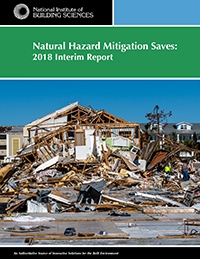"Natural hazards present significant risks to many communities across the United States. Fortunately, there are measures governments, building owners, developers, tenants, and others can take to reduce the impacts of such events. These measures—commonly called mitigation—can result in significant savings in terms of safety, and preventing property loss and disruption of day-to-day life."
"Mitigation Strategies Studied
The Institute’s Multihazard Mitigation Council (MMC) undertook a study to update and expand upon the findings of its 2005 Mitigation Saves study on the value of mitigation. The Interim Study analyzes four sets of mitigation strategies:
Beyond code requirements: The costs and benefits of designing all new construction to exceed select provisions in the 2015 IBC and the 2015 IRC and the implementation of the 2015 International Wildland-Urban Interface Code (IWUIC). This results in a national benefit of $4 for every $1 invested.
Adopting I-Code Requirements: Design based on meeting the 2018 IRC and IBC versus codes represented by 1990-era design and National Flood Insurance Program (NFIP) requirements—results in a national benefit of $11 for every $1 invested.
Infrastructure: Case studies for utility and transportation infrastructure based on Economic Development Administration (EDA) grants and California projects result in a national benefit of $4 for every $1 invested.
Federal grants: The impacts of 23 years of federal mitigation grants provided by FEMA, EDA, and the Department of Housing and Urban Development (HUD), resulting in a national benefit of $6 for every $1 invested."
Download the full interim report and learn more here.
